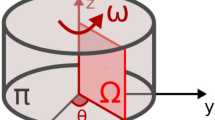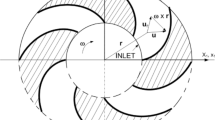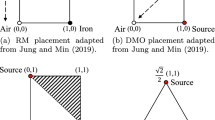Abstract
Flow machines are very important to industry, being widely used on various processes. Thus, performance improvements are relevant and can be achieved by using topology optimization methods. In particular, this work aims to develop a topological derivative formulation to design radial flow machine rotors by considering laminar flow. Based on the concept of traditional topology optimization approaches, in the adopted topological derivative formulation, solid or fluid material is distributed at each point of the domain. This is achieved by combining Navier–Stokes equations on a rotary referential with Darcy’s law equations. This strategy allows for working in a fixed computational domain, which leads to a topology design algorithm of remarkably simple computational implementation. In the optimization problem formulation, a multi-objective function is defined, aiming to minimize the energy dissipation, vorticity and power considering a volume constraint. The constrained optimization problem is rewritten in the form of an unconstrained optimization problem by using the Augmented Lagrangian formalism. The resulting multi-objective shape functional is then minimized with help of the topological derivative concept. In the context of this article, the topological derivative represents the exact sensitivity with respect to the nucleation of an inclusion within the design domain and the obtained analytical (closed) formula can be evaluated through a simple post processing of the solutions to the direct and adjoints problems. Both mentioned features allow for obtaining the optimized designs in few iterations by using a minimal number of user defined algorithm parameters. All equations and the derived continuous adjoint equations are solved through finite element method. As a result, two-dimensional designs of flow machine rotors are obtained by using this methodology. Their performance is analyzed by evaluating velocity and pressure distributions inside rotor.


















Similar content being viewed by others
References
Alnaes M, Logg A, Mardal K A, Skavhaug O, Langtangen H (2009) Unified framework for finite element assembly. Int J Comput Sci Eng 4(4):231–244
Alnæs M S, Logg A, Ølgaard K B, Rognes M E, Wells G N (2014) Unified form language. ACM Trans Math Softw 40(2):1–37
Amestoy P R, Duff I S, L’Excellent J-Y, Koster J (2001) A fully asynchronous multifrontal solver using distributed dynamic scheduling. SIAM J Matrix Anal Appl 23(1):15–41
Amstutz S (2005) The topological asymptotic for the navier-stokes equations. ESAIM: Control Optim Calcul Var 11:401–425
Amstutz S (2011a) Analysis of a level set method for topology optimization. Optim Methods Softw 26 (4-5):555–573
Amstutz S (2011b) Augmented Lagrangian for cone constrained topology optimization. Comput Optim Appl 49:101–122
Amstutz S, Andrȧ H (2006) A new algorithm for topology optimization using a level-set method. J Comput Phys 216(2):573–588
Amstutz S, Novotny A A, Van Goethem N (2014) Topological sensitivity analysis for elliptic differential operators of order 2m. J Diff Equa 256:1735–1770
Borrvall T, Petersson J (2003) Topology optimization of fluids in stokes flow. Int J Numer Methods Eng 41(1):77–107
Campeão D. E., Giusti S M, Novotny A A (2014) Topology design of plates consedering different volume control methods. Eng Comput 31(5):826–842
Casas V, Pena F, Duro R (2006) Automatic design and optimization of wind turbine blades. In: 2006 International conference on computational inteligence for modelling control and automation and international conference on intelligent agents web technologies and international commerce (CIMCA’06). IEEE, pp 205– 205
Derakhshan S, Pourmahdavi M, Abdolahnejad E, Reihani A, Ojaghi A (2013) Numerical shape optimization of a centrifugal pump impeller using artificial bee colony algorithm. Comput Fluids 81:145–151
Duan X, Li F (2015) Material distribution resembled level set method for optimal shape design of stokes flow. Appl Math Comput 266:21–30
Evgrafov A (2015) On chebyshevs method for topology optimization of stokes flows. Struct Multidiscip Optim 51(4):801–811
Gersborg-Hansen A (2003) Topology optimization of incompressible newtonian flows at moderate Reynolds numbers. Master’s thesis, Technical University of Denmark. Department of Mechanical Engineering Solid mechanics, Lyngby
Gersborg-Hansen A (2007) Topology optimization of incompressible newtonian flows at moderate Reynolds numbers. PhD thesis, Technical University of Denmark. Department of Mechanical Engineering Solid mechanics, Lyngby
Gölcü M, Pancar Y, Sekmen Y (2006) Energy saving in a deep well pump with splitter blade. Energy Conver Manag 47(5):638–651
Guillaume P, Hassine M (2008) Removing holes in topological shape optimization. ESAIM: Control Optim Calcul Var 14(1):160– 191
Guillaume P, Idris K S (2004) Topological sensitivity and shape optimization for the stokes equations. SIAM J Control Optim 43(1):1–31
Hansen MOL (2007) Aerodynamics of wind turbines, 2 edn. Routledge
Jafarzadeh B, Hajari A, Alishahi M, Akbari M (2011) The flow simulation of a low-specific-speed high-speed centrifugal pump. Appl Math Modell 35(1):242–249
Lee Y -T, Ahuja V, Hosangadi A, Slipper M E, Mulvihill L P, Birkbeck R, Coleman RM (2011) Impeller design of a centrifugal fan with blade optimization. Int J Rotat Mach 2011:1–16
Logg A, Wells G N (2010) DOLFIN: automated finite element computing. ACM Trans Math Softw 37 (2):1–28
Logg A, Wells G N, Book T F (2012) Automated solution of differential equations by the finite element method, volume 84 of lecture notes in computational science and engineering. Springer Berlin Heidelberg, Berlin, Heidelberg
Novotny AA, Sokołowski J (2013) Topological derivatives in shape optimization. Interaction of mechanics and mathematics. Springer
Othmer C (2008) A continuous adjoint formulation for the computation of topological and surface sensitivities of ducted flows. Int J Numer Methods Fluids 58:861–877
Plotnikov P, Sokołowski J (2012) Compressible Navier-Stokes equations. Theory and shape optimization. Springer-Verlag, Basel
Romero JS, Silva ECN (2014) A topology optimization approach applied to laminar flow machine rotor design. Comput Methods Appl Mech Engrg 279:268–300
Sá L F N, Amigo R C R, Novotny A A, Silva E C N (2016) Topological derivatives applied to fluid flow channel design optimization problems. Struct Multidiscip Optim 54(2):249–264
Sokołowski J, żochowski A (1999) On the topological derivative in shape optimization. SIAM J Control Optim 37(4):1251–1272
Wen-Guang L (2011) Inverse design of impeller blade of centrifugal pump with a singularity method. Jordan J Mech Indust 5(2):119–128
Yu S, Ng B, Chan W, Chua L (2000) The flow patterns within the impeller passages of a centrifugal blood pump model. Med Eng Phys 22(6):381–393
Acknowledgments
This research was partly supported by CNPq (Brazilian Research Council), FAPERJ (Research Foundation of the State of Rio de Janeiro) and FAPESP (Sao Paulo Research Foundation). The authors thank the supporting institutions. The first author thanks the financial support of FAPESP under grants 2016/19261-7, 2015/15189-7, 2013/24434-0, and 2014/50279-4. The fourth author thanks the financial support of CNPq (National Council for Research and Development) under grant 304121/2013-4.
Author information
Authors and Affiliations
Corresponding author
Rights and permissions
About this article
Cite this article
N. Sá, L.F., Novotny, A.A., Romero, J.S. et al. Design optimization of laminar flow machine rotors based on the topological derivative concept. Struct Multidisc Optim 56, 1013–1026 (2017). https://doi.org/10.1007/s00158-017-1698-0
Received:
Revised:
Accepted:
Published:
Issue Date:
DOI: https://doi.org/10.1007/s00158-017-1698-0




